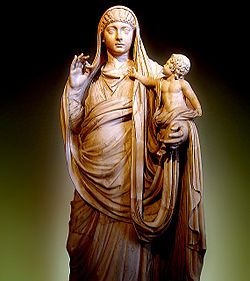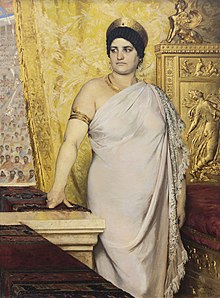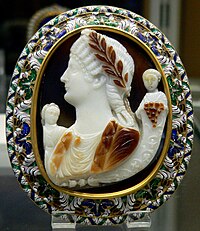Quick Facts

Biography
Valeria Messalina, sometimes spelled Messallina, (c. 17/20–48) was the wife of the Roman Emperor Claudius. She was a paternal cousin of the Emperor Nero, a second-cousin of the Emperor Caligula, and a great-grandniece of the Emperor Augustus. A powerful and influential woman with a reputation for promiscuity, she allegedly conspired against her husband and was executed on the discovery of the plot. Her notorious reputation arguably results from political bias, but works of art and literature have perpetuated it into modern times.
Early life

Messalina was the daughter of Domitia Lepida the Younger and her first cousin Marcus Valerius Messalla Barbatus. Her mother was the youngest child of the consul Lucius Domitius Ahenobarbus and Antonia Major. Her mother's brother, Gnaeus Domitius Ahenobarbus, had been the first husband of the future Empress Agrippina the Younger and the biological father of the future Emperor Nero, making Nero Messalina's first cousin despite a seventeen-year age difference. Messalina's grandmothers Claudia Marcella and Antonia Major were half sisters. Claudia Marcella, Messalina's paternal grandmother, was the daughter of Augustus' sister Octavia the Younger by her marriage to Gaius Claudius Marcellus Minor. Antonia Major, Messalina's maternal grandmother, was the elder daughter of Octavia by her marriage to Mark Antony, and was Claudius' maternal aunt. There was, therefore, a large amount of inbreeding in the family.
Little is known about Messalina’s life prior to her marriage in 38 to Claudius, her first cousin once removed, who was then about 48 years old. Two children were born as a result of their union: a daughter Claudia Octavia (born 39 or 40), a future empress, stepsister and first wife to the emperor Nero; and a son, Britannicus. When the Emperor Caligula was murdered in 41, the Praetorian Guard proclaimed Claudius the new emperor and Messalina became empress.
Reputation
With her accession to power, Messalina enters history with a reputation as ruthless, predatory and sexually insatiable. Her husband is represented as easily led by her and unconscious of her many adulteries. In 48 AD, he went away on a trip and was informed when he returned that Messalina had gone so far as to marry her latest lover, Senator Gaius Silius. While many would have ordered her death, the Emperor offered her another chance. Seeing that as weakness, one of his head officers went behind the Emperor's back and ordered Messalina's death. Upon hearing the news, the Emperor did not react and simply asked for another chalice of wine. The Roman Senate then ordered a damnatio memoriae so that Messalina's name would be removed from all public and private places and all statues of her would be taken down.

The historians who relay such stories, principally Tacitus and Suetonius, wrote some 70 years after the events in an environment hostile to the imperial line to which Messalina had belonged. Suetonius’ history is largely scandal-mongering. Tacitus claims to be transmitting ‘what was heard and written by my elders’ without naming sources other than the memoirs of Agrippina the Younger, who had arranged to displace Messalina’s children in the imperial succession and was therefore particularly interested in blackening her predecessor’s name. It has been argued that what passes for history is largely a result of the political sanctions that followed her death.
Accusations of sexual excess were a tried and tested smear tactic and the result of ‘politically motivated hostility’. Two accounts especially have added to her notoriety. One is the story of her all-night sex competition with a prostitute in Book X of Pliny the Elder's Natural History, according to which the competition lasted for 24 hours and Messalina won with a score of 25 partners. The poet Juvenal gives an equally well known description in his sixth satire of how the Empress used to work clandestinely all night in a brothel under the name of the She-Wolf. He also alludes to the story of how she compelled Gaius Silius to divorce his wife and marry her in his Satire X.
Ancestry
| Ancestors of Messalina | ||||||||||||||||||||||||||||||||||||||||||||||||||||||||||||||||||||||||||||||||||||||||||||||||||||||||||||||||||||||||||||||||||||||||||||||||||||||||||||||||||||||||||||||||||||||||||||||||||||||||||||||||||||||||||||||||||||||||||||||||||||||||||||||||||||||||||||||||||||||||||||||||||||||||||||||||||||||||||||||||||||||||||||||||||||||||||||||||||||||||||||||||||||||||||||||||||||||||||||||||||||||||||||||||||||||||||||||||||||||||||||||||||||||||||||||||||||||||||||||||||||
|---|---|---|---|---|---|---|---|---|---|---|---|---|---|---|---|---|---|---|---|---|---|---|---|---|---|---|---|---|---|---|---|---|---|---|---|---|---|---|---|---|---|---|---|---|---|---|---|---|---|---|---|---|---|---|---|---|---|---|---|---|---|---|---|---|---|---|---|---|---|---|---|---|---|---|---|---|---|---|---|---|---|---|---|---|---|---|---|---|---|---|---|---|---|---|---|---|---|---|---|---|---|---|---|---|---|---|---|---|---|---|---|---|---|---|---|---|---|---|---|---|---|---|---|---|---|---|---|---|---|---|---|---|---|---|---|---|---|---|---|---|---|---|---|---|---|---|---|---|---|---|---|---|---|---|---|---|---|---|---|---|---|---|---|---|---|---|---|---|---|---|---|---|---|---|---|---|---|---|---|---|---|---|---|---|---|---|---|---|---|---|---|---|---|---|---|---|---|---|---|---|---|---|---|---|---|---|---|---|---|---|---|---|---|---|---|---|---|---|---|---|---|---|---|---|---|---|---|---|---|---|---|---|---|---|---|---|---|---|---|---|---|---|---|---|---|---|---|---|---|---|---|---|---|---|---|---|---|---|---|---|---|---|---|---|---|---|---|---|---|---|---|---|---|---|---|---|---|---|---|---|---|---|---|---|---|---|---|---|---|---|---|---|---|---|---|---|---|---|---|---|---|---|---|---|---|---|---|---|---|---|---|---|---|---|---|---|---|---|---|---|---|---|---|---|---|---|---|---|---|---|---|---|---|---|---|---|---|---|---|---|---|---|---|---|---|---|---|---|---|---|---|---|---|---|---|---|---|---|---|---|---|---|---|---|---|---|---|---|---|---|---|---|---|---|---|---|---|---|---|---|---|---|---|---|---|---|---|---|---|---|---|---|---|---|---|---|---|---|---|---|---|---|---|---|---|---|---|---|---|---|---|---|---|---|---|---|---|---|---|---|---|---|---|---|---|---|---|---|---|---|---|---|---|---|---|---|---|---|---|---|---|---|---|---|---|---|---|---|---|---|---|---|---|---|---|---|---|---|---|---|---|---|---|---|---|---|---|---|---|---|---|---|---|---|---|---|---|---|---|---|---|---|---|---|
| ||||||||||||||||||||||||||||||||||||||||||||||||||||||||||||||||||||||||||||||||||||||||||||||||||||||||||||||||||||||||||||||||||||||||||||||||||||||||||||||||||||||||||||||||||||||||||||||||||||||||||||||||||||||||||||||||||||||||||||||||||||||||||||||||||||||||||||||||||||||||||||||||||||||||||||||||||||||||||||||||||||||||||||||||||||||||||||||||||||||||||||||||||||||||||||||||||||||||||||||||||||||||||||||||||||||||||||||||||||||||||||||||||||||||||||||||||||||||||||||||||||
Messalina in the arts

To call a woman 'a Messalina' indicates a devious and sexually voracious personality. The historical figure and her fate were often used in the arts to make a moral point, but there was often as well a prurient fascination with her sexually-liberated behaviour. In modern times, that has led to exaggerated works which have been described as romps.
The ambivalent attitude to Messalina can be seen in the late mediaeval French prose work in the J. Paul Getty Museum illustrated by the Master of Boucicaut, Tiberius, Messalina, and Caligula reproach one another in the midst of flames. It recounts a dialogue that takes place in hell between the three characters from the same imperial line. Messalina wins the debate by demonstrating that their sins were far worse than hers and suggests that they repent of their own wickedness before reproaching her as they had done.
While Messalina's wicked behavior towards others is given full emphasis, and even exaggerated in early works, her sexual activities have been treated more sympathetically. In the 1524 illustrations of 16 sexual positions known as I Modi, each was named after a couple from Classical history or myth, which included "Messalina in the Booth of Lisisca". Although early editions were destroyed by religious censorship, Agostino Caracci's later copies have survived (see above).
Later painting and sculpture

One of the few avenues to drawing a moral lesson from the story of Messalina in painting was to picture her violent end. An early example was Francesco Solimena's The Death of Messalina (1708). In this scene of vigorous action, a Roman soldier pulls back his arm to stab the Empress while fending off her mother. A white-clad witness observes calmly from the shadows in the background. Georges Rochegrosse's painting of 1916 is a reprise of the same scene. A mourning woman dressed in black leaves with her face covered as a soldier drags back Messalina's head, watched by a courtier with the order for execution in his hand. An earlier French treatment by Victor Biennoury (1823 - 1893) makes the lesson plainer by specifically identifying the scene of her death as the garden which she had obtained by having its former owner executed on a false charge. She crouches at the foot of a wall carved with the name of Lucullus and is denounced by a dark-clothed figure as a soldier advances on her drawing his sword.
Other artists show scenes of debauchery or, like the Italian A. Pigma in When Claudius is away, Messalina will play (1911), hint that it will soon follow. What was to follow is depicted in Federico Faruffini's The orgies of Messalina (1867-1868). A more private liaison is treated in Joaquín Sorolla y Bastida's Messalina in the Arms of the Gladiator (1886). This takes place in an interior, with the empress reclining bare breasted against the knees of a naked gladiator.
Juvenal's account of her nights spent in the brothel is commonly portrayed. Gustave Moreau paints her leading another man onto the bed while an exhausted prostitute sleeps in the background, while in Paul Rouffio's painting of 1875 she reclines bare-breasted as a slave offers grapes. The Dane Peder Severin Krøyer depicts her standing, her full body apparent under the thin material of her dress. The ranks of her customers are just visible behind the curtain against which she stands (see above). Two drawings by Aubrey Beardsley were produced for a private printing of Juvenal's satires (1897). The one titled Messalina and her companion shows her on the way to the brothel, while a rejected drawing is usually titled Messalina returning from the bath.
Alternatively, artists drew on Pliny's account of her sex competition. The Brazilian Henrique Bernardelli (1857-1936) shows her lying across the bed at the moment of exhaustion afterwards. So also does Eugène Cyrille Brunet's dramatic marble sculpture, dating from 1884 (see above), while the Czech Jan Štursa's standing statue of 1912 shows her holding a last piece of clothing at her side at the outset.
Stage productions

One of the earliest stage productions to feature the fall of the empress was The Tragedy of Messalina (1639) by Nathanael Richards, where she is depicted as a monster and used as a foil to attack the Roman Catholic wife of the English king Charles I. She is treated as equally villainous in the Venetian Pietro Zaguri's La Messalina (1656). This was a 4-act prose tragedy with four songs, described as an opera scenica, that revolved around the affair with Gaius Silius that brought about her death. Carlo Pallavicino was to follow with a full blown Venetian opera in 1679 that combined eroticism with morality.
During the last quarter of the 19th century the idea of the femme fatale came into prominence and encouraged many more works featuring Messalina. 1875 saw the German verse tragedy Arria und Messalina by Adolf Wilbrandt in which Charlotte Wolter starred as the Empress. That year too Hans Makart painted her in the role. It was followed two years later in Italy by Pietro Cossa's tragedy, in which Messalina figures as a totally unrestrained woman in pursuit of love, and by Luigi Danesi's ballet. In the USA there was a 5-act tragedy by Algernon Sydney Logan 1849-1925, who had liberal views on sex.
Isidore de Lara's opera Messaline (1900) inspired Henri de Toulouse-Lautrec to a series of paintings, including Messalina Seated and Messalina descending the staircase. In 1914 there was a 3-act German Expressionist tragedy by Hermann Kesser, Kaiserin Messalina. In 2009 the theme was updated by Benjamin Askew in his UK play In Bed With Messalina, which features her final hours.
Films and television
Messalina has been portrayed many times in movies and television films or miniseries, played by these actresses:
- Maria Caserini in the 1910 Italian silent film Messalina, directed by Enrico Guazzoni.
- Rina De Liguoro in the 1924 Italian silent film Messalina, alternatively titled The Fall of an Empress, directed by Enrico Guazzoni. A cut version with dubbed dialogue was released in 1935.
- Merle Oberon in the 1937 uncompleted film of I, Claudius, directed by Josef von Sternberg.
- María Félix in the 1951 Italian film Messalina, directed by Carmine Gallone. This also carried the titles Empress of Rome and The Affairs of Messalina.
- Ludmilla Dudarova during a flashback in Nerone e Messalina, (Italy, 1953), which had the English title Nero and the Burning of Rome
- Susan Hayward in the 1954 Biblical epic Demetrius and the Gladiators, a completely fictionalized interpretation in which a reformed Messalina bids a penitential public farewell to her Christian gladiator lover, Demetrius, and takes her place on the throne next to her husband, the new emperor Claudius.
- Belinda Lee in the 1960 film Messalina, venere imperatrice.
- Lisa Gastoni in the Italian L’Ultimo Gladiatore, also titled Messalina vs. the Son of Hercules (1964), directed by Umberto Lenzi.
- Nicola Pagett in the 1968 ITV television series The Caesars. The series is noted for its historically accurate depiction of Roman history and personages, including a less sensationalised portrayal of Messalina.
- Sheila White in the 1976 BBC serial I, Claudius.
- Anneka Di Lorenzo in the 1979 film Caligula, and the 1977 comedy Messalina, Messalina, which used many of the same set pieces as the earlier-filmed, but later released Caligula. An alternative European title for the 1977 production was Messalina, Empress and Whore.
- Betty Roland in the Franco-Italian Caligula and Messalina (1981), directed by Bruno Mattei.
- Raquel Evans in the 1982 Spanish comedy Bacanales Romanas, also known as My Nights with Messalina. directed by Jaime J. Puig.
- Jennifer O'Neill in the 1985 TV series A.D..
- Kelly Trump in the 1996 adult film Messalina, directed by Joe D'Amato.
- Sonia Aquino in the 2004 TV movie Imperium: Nero.
- Tabea Tarbiat in the 2014 film Nymphomaniac Volume II, by Lars von Trier.
Novels
An early fiction concerning the Empress, La Messalina by Francesco Pona, appeared in Venice in 1633. This managed to combine a high degree of eroticism with a demonstration of how private behavior has a profound effect on public affairs. Nevertheless, a passage such as
helps explain how the novel was at once among the most popular, and the most frequently banned, books of the century, despite its moral pretentions. Much the same point about the catastrophic effect of sexuality was made by Gregorio Leti's political pamphlet, The amours of Messalina, late queen of Albion, in which are briefly couch'd secrets of the imposture of the Cambrion prince, the Gothick league, and other court intrigues of the four last years reign, not yet made publick (1689). This was yet another satire on a Stuart Queen, Mary of Modena in this case, camouflaged behind the character of Messalina.

In 19th century France, the story of Messalina is subject to literary transformation. It underlies La femme de Claude (Claudius' wife, 1873), the novel by Alexandre Dumas fils, where the hero is Claude Ruper, an embodiment of the French patriotic conscience after the country's defeat in the Franco-Prussian War. In contrast, his wife Césarine (the female Caesar) is a creature totally corrupt at all levels, who sells her husband’s work to the enemy and is eventually shot by him. Alfred Jarry's 'pataphysical' novel Messaline of 1901 (titled The Garden of Priapus in Louis Colman's English translation), though lightly based on the historical account, is chiefly the product of the author's fanciful and extravagant imagination and has been compared with the treatment of Classical themes by Art Nouveau artists.
A very early treatment in English of Messalina's liaison with Gaius Silius and her subsequent death appears in the fictionalised story included in the American author Edward Maturin's Sejanus And Other Roman Tales (1839). But the part she plays in Robert Graves' novels I, Claudius, and Claudius the God (1934–35) is better known. In it she is portrayed as a teenager at the time of her marriage but credited with all the actions mentioned in the ancient sources. An attempt to create a film based on them in 1937 failed, but they were adapted into a very successful TV series in 1976.
More sensational fictional treatments occur in Vivian Crockett's Messalina, the wickedest woman in Rome (1924) and Jack Oleck's Messalina: a novel of imperial Rome (1959). Oleck's novel went through many editions and was later joined by Kevin Matthews' The Pagan Empress (1964). Both have since been included under the genre "toga porn". More recently, there has been the 2002 German novel by Siegfried Obermeier, Messalina, die lasterhafte Kaiserin (The empress without principle).
